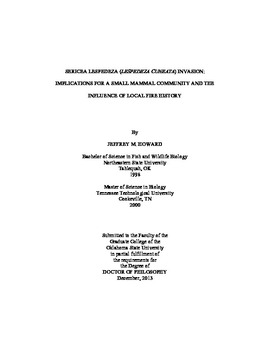| dc.contributor.advisor | Baum, Kristen A. | |
| dc.contributor.author | Howard, Jeffrey M. | |
| dc.date.accessioned | 2015-06-17T20:06:21Z | |
| dc.date.available | 2015-06-17T20:06:21Z | |
| dc.date.issued | 2013-12 | |
| dc.identifier.uri | https://hdl.handle.net/11244/14892 | |
| dc.description.abstract | Lespedeza cuneata [(Dumont) G. Don] is a perennial legume first introduced to North America from eastern Asia in 1896 and is now widespread and well established across much of the eastern and central United States. Possible impacts of invasion and mechanisms of spread however are poorly understood. I assessed the influence of three L. cuneata cover classes (i.e., < 5%, 15 - 20%, and > 25% per m2) on a small mammal community in eastern Oklahoma (February 2010 to December 2011). I also examined the relationship between local fire history and L. cuneata cover and also considered the effect of plant invasion on the vegetation community in these same areas. My results indicate small mammal community diversity decreased with increasing L. cuneata cover, while Sigmodon hispidus body mass and catch rate increased with increasing L. cuneata cover. Lespedeza cuneata invasion decreased numbers of other species, such as Peromyscus maniculatus, Neotoma floridana, P. attwateri, and Microtus pinetoru. Model selection and multimodel inference indicated catch rates for common species were most influenced by vegetation height and occurrence of bare ground, while L. cuneata cover and vegetation richness exerted variable influence. For the fire history analysis, mean fire return interval (MFI) alone explained 75% of the variation in L. cuneata cover and the relationship was negative. Additionally, L. cuneata invasion suppressed graminoid cover. I provide evidence to indicate continued loss of habitat heterogeneity due to L. cuneata invasion will likely favor a community composed of relatively few, but individually abundant small mammal species. My findings also reveal for the first time the possible relationship between MFI and L. cuneata cover. My dissertation adds to the literature that indicates invasive plants are capable of modifying habitat structure and ecological conditions under which native organisms evolved. | |
| dc.format | application/pdf | |
| dc.language | en_US | |
| dc.rights | Copyright is held by the author who has granted the Oklahoma State University Library the non-exclusive right to share this material in its institutional repository. Contact Digital Library Services at lib-dls@okstate.edu or 405-744-9161 for the permission policy on the use, reproduction or distribution of this material. | |
| dc.title | Sericea lespedeza (Lespedeza cuneata) invasion: Implications for a small mammal community and the influence of local fire history | |
| dc.contributor.committeeMember | Luttbeg, Barney | |
| dc.contributor.committeeMember | Fuhlendorf, Samuel D. | |
| dc.contributor.committeeMember | Steets, Janette A. | |
| osu.filename | Howard_okstate_0664D_13099.pdf | |
| osu.accesstype | Open Access | |
| dc.type.genre | Dissertation | |
| dc.type.material | Text | |
| dc.subject.keywords | fire history | |
| dc.subject.keywords | invasive species | |
| dc.subject.keywords | lespedeza cuneata | |
| dc.subject.keywords | mean fire return interval | |
| dc.subject.keywords | sigmodon hispidus | |
| dc.subject.keywords | small mammals | |
| thesis.degree.discipline | Zoology | |
| thesis.degree.grantor | Oklahoma State University | |
